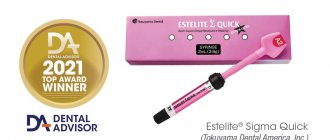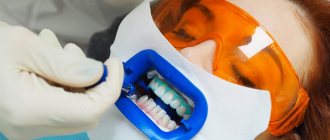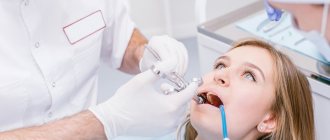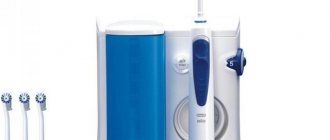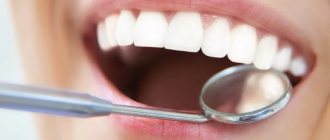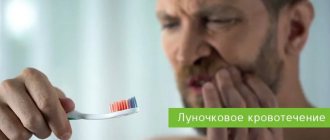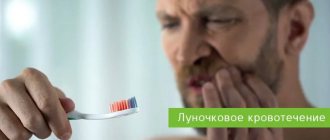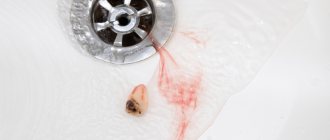What can and cannot be done after tooth extraction
- What to do after tooth extraction
- What to do after wisdom tooth removal
- What not to do
- What do we have to do
- What to do after tooth root removal
- Baths after tooth extraction
- What to do after a child’s tooth extraction
- What to do after removing a tooth with a cyst
- Temperature rises after tooth extraction
Tooth extraction is a major dental operation.
The recovery period after such a procedure can take some time and last from three days to seven days. There are indications and contraindications for what measures the patient needs to take to ensure that the rehabilitation process goes as quickly and successfully as possible. If you strictly follow the dentist’s recommendations and the general rules of the postoperative period, you can significantly bring the moment of recovery closer and avoid unpleasant or even dangerous complications. Rules of conduct during recovery after a doctor has pulled out a tooth may differ depending on the severity of the operation performed, its type, the general health of the patient, his habits and age. However, there are general recommendations that are relevant for any postoperative situation.
How is the affected tooth removed?
The procedure itself should only be performed by an experienced surgeon and only when other treatment methods can no longer help. There are a number of reasons that can trigger the removal of an affected tooth:
- if the crown of the tooth is completely destroyed;
- when the patient is indicated for prosthetics;
- if complications arise during the eruption of a wisdom tooth;
- if filling requires perforation of the root canal.
Important ! There are cases when there is every reason to remove a tooth, but the patient has contraindications to this. In such cases, most often the intervention is carried out within the walls of a hospital with subsequent monitoring of the patient’s condition.
There are a number of main contraindications to surgical tooth extraction. These include:
- previous heart attacks;
- high blood pressure;
- arrhythmia;
- blood diseases;
- mental problems or neurological diseases.
If no contraindications have been identified in a patient who needs surgical removal of the affected tooth, then he is referred to the procedure itself, which should be carried out according to the following scheme.
| Stage | Description |
| Visit doctor | Before performing the procedure, the doctor must find out whether the patient has allergic reactions to any anesthetics, cardiovascular pathologies, or whether the patient suffers from hypertension. |
| Anesthesia | After all the necessary information has been obtained, the patient is sent for anesthesia. A fairly large number of different means are currently used to remove teeth. Their duration of action is from forty minutes to three hours. |
| Preparation | Next comes preparation for the intervention itself: in order not to injure the gum during manipulation, it first peels off from the tooth bone by at least five millimeters. This procedure is carried out using a special tool. The surgeon places special forceps on the tooth, and then begins to swing the tooth itself with them in order to destroy the ligaments attached to the jaw bone. |
| Removal | The affected tooth itself is pulled out, that is, extraction. After the affected tooth has been removed, the resulting hole must be thoroughly examined. This is necessary so as not to leave tooth fragments or a cyst in the wound cavity. If the extraction of the affected tooth took place in the presence of flux, then after its removal the gums are cut in the right place and the pus is released. After this manipulation, a drainage is inserted into the wound cavity. |
| Treatment | After the procedure is completed, you need to treat the wound itself. If pus is found at the site of the lesion, then in this case the hole must be washed with an antiseptic solution, and then an anti-inflammatory agent should be placed in the wound. If the hole itself is too large after extracting the tooth, then a suture is necessary. |
| Consultation | After the procedure has been completely completed, before discharge, the doctor must instruct the patient in detail on how to care for the hole during the healing period, and also prescribe any medications if necessary. |
After the tooth is removed and before the patient goes home, the doctor inserts a special medicine into the tooth socket. It is necessary to protect the wound from various influences, as well as for faster and more proper healing. Some patients complain that the turunda with the medicine interferes greatly, but this will have to be endured.
Important ! If you remove the turunda ahead of time, serious complications may develop, which will have to be dealt with not only by the dentist, but also by other doctors.
The doctor prescribes exactly the medicine that is safe for every person. True, it does not have the most pleasant taste, but a person will have to ignore this factor if he wants the wound to heal as quickly as possible.
There are exceptional cases when it is simply impossible to remove the affected tooth according to the scheme above. The reason for this may be the following factors:
- if the tooth root is crooked;
- if the bone tissue of the tooth is too fragile;
- if the crown of the affected tooth is already completely destroyed;
- if the figure eight is in a position of incomplete eruption or in a horizontal position.
If a patient who needs tooth extraction has any of these characteristics, then the intervention is performed in a different way. First, the gum is cut and peeled away from the bone. After this, the specialist drills out the desired area using a drill, which creates access to the root of the required tooth.
Important ! In some cases, the partitions between the roots of the tooth are sawed, after which each root is removed one by one.
After such procedures, healing is more difficult and longer. Such an intervention may cause the patient to develop stomatitis. In many cases of such intervention, a secondary infection is attached to the affected area.
However, no matter which tooth is removed, medicine must be placed in the hole. This procedure is required.
What to do after tooth extraction
After the dentist has completed all removal procedures, the patient must take the following measures:
- The tampon that the doctor placed on the hole must be removed no later than half an hour later. If the patient has poor blood clotting, you can keep the compression pad on for 60 minutes;
- To reduce the likelihood of swelling of the soft tissues of the mouth or face, it is advisable to apply something cold to the cheek. This treatment measure will be effective only in the first hours after surgery. A piece of ice or frozen meat wrapped in cloth should be applied to the cheek several times for 5 minutes;
- On the first day, to avoid inflammation, you can do antiseptic baths;
- It is necessary to gently, carefully, but carefully carry out all hygiene procedures in the oral cavity, not excluding the area where the tooth was pulled out.
Compliance with these rules after removal will promote rapid healing of the hole and prevent infection.
How long does it take for a hole to heal?
The wound left after tooth extraction has a certain healing pattern.
- After the tooth extraction procedure is completed, the circular ligament located around the crown of the extracted tooth begins to contract.
- A short amount of time after the procedure, you may notice an accumulation of blood in the hole. The resulting clot helps protect the wound from infection or small food particles. Over time, the hole begins to become overgrown with fibrous tissue.
- After a certain amount of time, which depends on the characteristics of the human body, as well as on the correct care of the hole after the procedure, the surface of the wound heals and the affected area of the gum is restored.
- After this, over time, new epithelium grows on the surface of the gum, as well as the development of bone tissue at the site of tooth extraction.
Important ! The normal healing of the hole is facilitated by the medicine that is placed in the hole. Without it, the wound will not heal.
Many patients worry about the healing of the wound that remains after tooth extraction. The doctor must explain to the patient that the wound can heal completely only after two or three weeks, provided that all care rules are followed. If they were nevertheless broken or an infection was still able to penetrate the wound, then with repeated disinfection, complete restoration of the affected area will occur in five months.
What is allowed during the healing period?
- Non-solid semi-liquid food.
- Gentle oral hygiene.
What is prohibited during the healing period?
- Drinking alcohol and smoking cigarettes.
- Drinking liquids with a plastic straw.
- Harsh brushing of teeth in general and especially in the healing area.
- Eating dry and solid food.
- Sudden movements of the cheekbones for one week after the procedure.
What to do after wisdom tooth removal
The third molar is usually pulled out due to inflammation that appears around it. At the same time, pus and infectious agents are likely to get into the wound. Therefore, in the postoperative period, the patient must follow general recommendations, as well as be as attentive as possible to his feelings, and note the slightest changes in his condition.
As soon as the hole stops bleeding, you should immediately remove the compression tampon. Its presence in the wound provokes the proliferation of bacteria and increases the likelihood of the onset of an inflammatory process.
The patient should be prepared for the fact that his gums will hurt for 3-5 days after the procedure. You need to purchase recommended anesthetics and take them on schedule. If the pain syndrome has become stronger, swelling of the face and gums increases over the course of several days, the elevated temperature does not subside, and an unpleasant odor begins to come from the socket, you need to call the dentist.
What not to do
In order to avoid any complications after surgery to remove any tooth, you must follow the following rules:
- Do not eat or drink anything for 3 hours after surgery;
- It is not recommended to eat hot, spicy, hard and fine-grained foods, or drink hot drinks. The load when chewing food must be transferred to the healthy side of the jaw;
- For 3 days, limit physical activity and procedures that increase blood pressure or increase blood flow. Do not take hot baths. Bathhouse, sauna, solarium, visiting the beach are prohibited;
- Do not touch the hole with your tongue, finger, toothbrush, or toothpick;
- Do not rinse your mouth;
- Do not ignore the advice, recommendations and prescriptions of the dentist. Do not violate your medication schedule.
If the patient has any doubts about his condition or questions for the doctor, he should not put off calling the clinic “for later.”
About the medicine
The medicine that is placed in the hole can be applied to a piece of gauze, which is subsequently inserted into the hole. In this case, after a certain amount of time indicated by the doctor, it needs to be taken out. This can be done either independently or during your next visit to the dentist. If this is not done in time, the process of putrefaction may begin, which will greatly complicate the situation. It is also not recommended to take out the gauze ahead of time, since food particles can get into the hole and the tongue can touch it, which will interrupt the healing process and also cause complications.
There is another way to install the medicine - in a hemostatic sponge. It already contains a medicine that helps disinfect the socket cavity and helps stop bleeding. You cannot take this sponge out - it will dissolve on its own. Most often this happens within 1-2 days, but in some cases the sponge may remain in the hole for 5-6 days. There is no need to be afraid of this. As a last resort, you can consult a doctor who will examine the wound and determine whether healing is proceeding normally.
Often the medicine in the sponge is very bitter, and this causes severe discomfort to the person. Unfortunately, nothing can be done about this, since getting rid of the sponge ahead of time is strictly contraindicated. To eliminate bitterness, you can drink sweet tea or juice.
Remember ! No circumstances can influence the ability to remove the medicine from the hole ahead of time. After 3-4 days, the surface of the hole will heal, and you will no longer have to experience discomfort.
People often wonder what kind of medicine is used for these purposes. Sometimes the gauze that is placed in the hole is treated with iodine - this will both disinfect the wound and prevent bleeding. The hemostatic sponge is already treated with a special substance consisting of boric acid, collagen and nitrofural, which helps stop the bleeding and protect the hole from various influences. But most often dentists use Alvozhil.
No other means are used for inserting into the hole.
What do we have to do
After the removal procedure, you need to limit your activity for a while, adhere to a healthy lifestyle and diet.
It is better to take the so-called “sick leave” - spend time at home in a calm environment, closely monitoring your condition.
Smoking and drinking alcoholic beverages are prohibited; it is better to abstain from them.
The menu for the recovery period should consist of nutritious food that does not require thorough chewing. It is better to reduce the number of meals by increasing the calorie content of dishes.
It is imperative to carry out hygienic procedures, since ignoring them can trigger an inflammatory process in the socket of an extracted tooth.
Mouth rinsing is prohibited; it is better to replace it with medicinal baths.
You need to make sure that the postoperative sutures do not come apart; to do this, you should not open your mouth wide or strain your facial muscles.
What to do after tooth root removal
Root removal is often accompanied by circumstances that complicate the dentist’s work and can negatively affect the duration and course of the recovery period.
In order for rehabilitation to progress at a normal pace and tooth reconstruction to begin, the patient must follow the rules of the recovery period.
First of all, it is necessary to avoid the occurrence of inflammation in the area of the torn root. For this you will need:
- Observe the rules of personal hygiene;
- Do not overheat the head area;
- Do not rinse or touch the affected area with your tongue;
- Do medicinal baths, take painkillers, start taking antibiotics if the doctor gives such a recommendation.
You should try to protect the area of the torn root as much as possible, since any infectious process at the site of removal can lead to serious complications.
Genoss bone replacement materials
Genoss are bone substitutes of the highest quality, which have been successfully used in dentistry for a very long time.
When are Genoss osteoplastic materials used?
Genoss have proven themselves to be excellent in filling sockets at the site of an extracted tooth, dental implantation, bone ridge plastic surgery, filling cystic hilar cavities, in the case of post-osteotomy techniques, in restoring periodontal tissues, and filling cavities during sinus lifting.
Benefits of Genoss
- One hundred percent biocompatibility with tissues of the human body.
- High resorbability.
- Rapid tissue healing.
- Improvement of hemostasis.
- Easy to use.
Baths after tooth extraction
Since rinsing after the removal procedure is prohibited, it is necessary to make baths.
Doctors usually recommend making baths using soda and salt, medications or decoctions of various medicinal herbs. For these purposes, drugs such as Miramistin and an aqueous solution of Chlorhexidine are suitable.
The procedure is easy to carry out. You just need to put a small amount of bath liquid in your mouth, tilt your head so that the liquid moves to the area of the pulled out tooth, and freeze in this position for 30-60 seconds. There is no need to take any active action; the medicinal solution should simply gently wash the damaged gum tissue. After this, the liquid must be spat out.
Antiseptic or therapeutic baths are recommended to be done every 3 hours during the day, preferably after eating and cleansing the mouth.
After the patient has taken a bath, it is advisable not to eat any food or even drink for 1 hour.
What painkillers can be taken in the postoperative period?
Most often, when local anesthesia wears off after a tooth extraction procedure, the patient feels pain in the area of intervention. The best way to eliminate pain is to take NSAIDs. This group of drugs is the most effective in eliminating toothache.
- The drugs "Nurofen" or "Ibuprofen" cope well with pain after surgery. It is necessary to take the drug 500-800 mg three to four times a day, depending on the intensity of the pain.
- "Ketorol" is one of the most effective and powerful drugs from the NSAID group, which can eliminate pain after the procedure in a fairly short time. It is also used two tablets three to four times throughout the day.
What to do after a child’s tooth extraction
After removing a child’s baby or molar teeth, parents should closely monitor the baby’s condition and well-being.
It is necessary to ensure that the child follows the following rules:
- Do not rinse your mouth or spit, as this may cause the blood clot to be removed from the socket;
- Did not engage in vigorous physical exercise and did not overheat;
- Brush your teeth efficiently and responsibly, avoiding the injured area with a brush;
- Take the necessary medications in full and according to the schedule established by the doctor;
- Carefully and promptly made baths with antiseptic or medicinal products;
- He did not put any foreign objects in his mouth and did not touch the socket with his fingers or tongue.
The child’s body temperature, swelling of soft tissues and the child’s breath must be monitored. In case of complications, consult a doctor immediately.
What to do after removing a tooth with a cyst
After the doctor removes a tooth with a cyst, you need to follow the general recommendations of the recovery period, but pay special attention to reducing the likelihood of infection of the wound.
In the initial period after the procedure, it is necessary to cool the sore side of the jaw by applying 3-4 cold compresses. Next, you need to ensure that the operated part of the face does not overheat. It is forbidden to make warming compresses, take hot baths, or sunbathe. For pain relief, you can take medications prescribed by your doctor.
It is necessary to avoid injuring the healing hole - the food is soft or liquid, not hot; brush your teeth as carefully as possible; Do not rinse your mouth. It is necessary to limit physical activity and monitor local and general temperature. If pain, high body temperature and swelling lasts more than 2 days, consult a doctor. If pus begins to discharge or there is an unpleasant odor coming from the hole, consult a doctor immediately.
What should the patient do after the procedure?
After the procedure has been completed, the specialist must carefully explain to the patient his next steps, as well as the rules for caring for the wound during the healing period.
- The turunda or cotton wool that was left by the surgeon in the hole does not need to be removed by yourself. If the tampon placed by the doctor falls out ahead of schedule, the patient must return to the specialist to install a new turunda. If this is not done, an infection may enter the wound cavity.
- If after the procedure the cheek is very swollen, you can apply ice or a cold compress to it. After this procedure, it is forbidden to heat the affected area and apply hot compresses.
- You can eat food after tooth extraction only two hours after the procedure. It is recommended to eat only liquid and light foods that do not contain solid pieces.
- A blood clot forms in the hole where the tooth was pulled out. It is prohibited to remove it or touch it. The first time after the procedure, you must brush your teeth with caution and do not use any rinses.
- For 7 days after tooth extraction, it is prohibited to carry out other interventions in the oral cavity.
- During the healing period, it is not recommended to overheat, for example, take a steam bath, and also exercise with caution. It is also strongly recommended to stop drinking alcoholic beverages and smoking cigarettes for two days after the procedure.
- After tooth extraction, pain often occurs at the extraction site. In this case, quite often not only the hole, but the whole head as a whole can hurt. Also, the patient may experience pain while eating, regardless of which side of the teeth he chews on. Experts recommend coping with these problems with the help of painkillers, such as Pentalgin or Tempalgin. In this case, it is advisable to take the drug in combination with Suprastin.
Despite the fact that there is medicine in the hole, a person may still feel pain and some burning. Such unpleasant sensations will have to be ignored.
Important ! If the sensations intensify, it is recommended to consult a doctor again so that he can examine the wound and, if necessary, take action.
Temperature rises after tooth extraction
A slight increase in general body temperature or local temperature in the area of the operation is considered normal. This is the body's natural reaction to dental surgery.
If the temperature stays within 37-38° C, there is no need to bring it down. If it rises above 38° C, you need to take antipyretic drugs. Avoid using aspirin as it may cause bleeding from the socket.
An increase in temperature over a long period (2 or more days in a row), accompanied by signs of inflammation - severe pain, swelling, swelling of soft tissues, an unpleasant odor from the wound, are direct indications for urgent medical attention.
